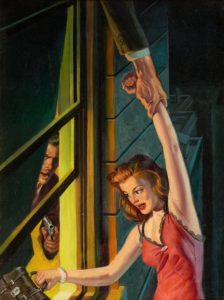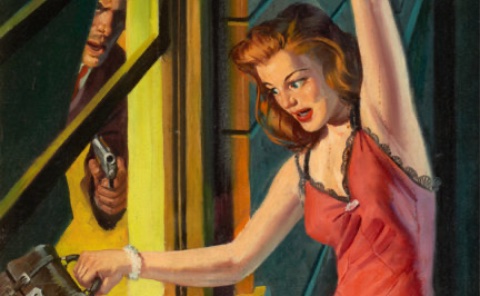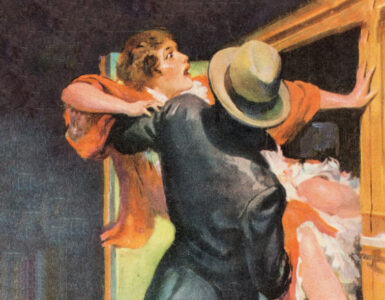 When his mother introduced him to the motion picture at the age of three — they saw Lon Chaney as THE HUNCHBACK OF NOTRE DAME — Ray Bradbury should have been a perfect fit for Hollywood. Unfortunately, that has not always been the case.
When his mother introduced him to the motion picture at the age of three — they saw Lon Chaney as THE HUNCHBACK OF NOTRE DAME — Ray Bradbury should have been a perfect fit for Hollywood. Unfortunately, that has not always been the case.
Ray Bradbury made his first professional sale in 1941, a collaboration with Henry Hasse that sold to SUPER SCIENCE STORIES. Within five years, his stories were being adapted for the mass medium – not Hollywood – but radio. NBC’s MOLLÉ MYSTERY THEATRE broadcast “Killer Come Back To Me” on May 17, 1946. Originally appearing in the July 1944 issue of Popular Publications’ DETECTIVE TALES, the novella was one of the young author’s first sales to the detective pulps. The issue featured cover art by Rafael DeSoto.
The NBC radio drama was followed over the years by adaptations on SUSPENSE, RADIO CITY PLAYHOUSE, ESCAPE and DIMENSION X. A 1950 – 51 NBC science fiction program, DIMENSION X was one of the first weekly “adult” science fiction anthology programs to be featured on radio. Considering that Bradbury’s stories were adapted for ten of its fifty episodes, his work was almost certainly admired by the creators and listeners of DIMENSION X.
Ray Bradbury had not yet written FAHRENHEIT 451 nor assembled DANDELION WINE — two of his finest works — when his work and DIMENSION X caught the attention of Hollywood. George Pal used the radio program to promote his 1950 science fiction film, DESTINATION MOON. The film was also adapted by the NBC radio drama. A few years later, Harry Essex wrote the screenplay for IT CAME FROM OUTER SPACE, largely following the shot sequence and the dialog from Bradbury’s original screen treatment. A sequence in the Warner Brothers film, THE BEAST FROM 20,000 FATHOMS, was tenuously based on Bradbury’s short story of the same title. It had been published in THE SATURDAY EVENING POST for June 23, 1951. John Huston’s 1956 film adaptation of Herman Melville’s MOBY DICK is essentially the work of Ray Bradbury.
Throughout the 1950s and early 1960s, Bradbury’s stories were also adapted for television, including a few teleplays by Bradbury himself. Among the notables were ABC’s live TALES OF TOMORROW, ALFRED HITCHCOCK PRESENTS, and an original Christmas story for television’s STEVE CANYON. In 1961, Alfred Hitchcock secretly produced an hour-long television pilot, “The Jail,” another original by Bradbury for television. Unfortunately, the program never found a sponsor.
Rod Serling successfully launched his science fiction and fantasy classic, THE TWILIGHT ZONE, in 1959. The CBS program certain owed a lot to Bradbury, who recommended both Charles Beaumont and Richard Matheson to Serling. Bradbury also wrote several scripts for the series, although only one was produced. Unfortunately, the show spawned a good deal of professional jealousy between the two talented scribes.
Several years after the brilliant adaptations of Ray Bradbury’s “The Jar” and “The Life Work of Juan Diaz” for THE ALFRED HITCHCOCK HOUR in 1964, Francois Truffaut directed FAHRENHEIT 451 (1966) and Jack Smight brought THE ILLUSTRATED MAN (1969) to life on celluloid. In 1980, Bradbury’s friend, Richard Matheson wrote the script for THE MARTIAN CHRONICLES, an NBC miniseries that ran in 1980. Disney released SOMETHING WICKED THIS WAY COMES in 1983. The final release features re-shoots that were co-directed by Bradbury. More recently, THE SOUND OF THUNDER — based on the author’s 1952 short story of the same title — was considered to be one of the worst films of 2005.
Perhaps the most successful filmed adaptations of his work were THE RAY BRADBURY THEATER — a Canadian-produced anthology series scripted by the author that ran on HBO and the USA Network from 1985 through 1992 — and THE HALLOWEEN TREE, an animated film produced by Hanna-Barbera for TBS. Bradbury received an Emmy Award for the latter in 1994.
To extensively cover the cinematic achievements of Ray Bradbury in less than an hour would require the imaginary visions of Bradbury’s time-travel concepts. Author Martin Grams, Jr. will present some of the highlights from the Hollywood career of Ray Bradbury featuring never-published archival materials. He’ll discuss Bradbury’s ten-year lawsuit against CBS for an unauthorized and uncredited adaptation of FAHRENHEIT 451 for PLAYHOUSE 90, examine the professional differences between Bradbury and Rod Serling, and more.
Join Martin at 9:30 PM on Friday, August 7, for “Bradbury in Hollywood,” one of the many informative and entertaining presentations planned for PulpFest 2020.
(Martin Grams, Jr. was 18 years old when he published his first book, a history of the radio/TV series, SUSPENSE. Since then, he has authored or co-authored over thirty books; contributed chapters, essays and appendices for numerous books; and written magazine articles for FILMFAX, SCARLET STREET, and Ed Hulse’s BLOOD ‘N’ THUNDER, to name just a few. He is the founder and organizer of the Mid-Atlantic Nostalgia Convention, a three-day festival featuring Hollywood celebrities signing autographs, vendors offering vintage memorabilia and collectibles, seminars and more.
For a look at our entire programming schedule, please click the Programming button below the PulpFest banner on our home page.)







